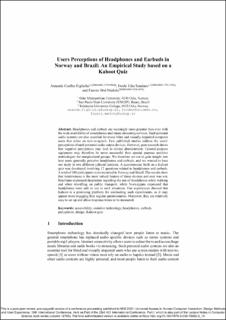Users Perceptions of Headphones and Earbuds in Norway and Brazil: An Empirical Study Based on a Kahoot Quiz
Conference object
Accepted version

View/
Date
2021-07-03Metadata
Show full item recordCollections
Original version
https://doi.org/10.1007/978-3-030-78092-0_10Abstract
Headphones and earbuds are seemingly more popular than ever with the wide availability of smartphones and music streaming services. Such personal audio systems are also essential for many blind and visually impaired computer users that relies on text-to-speech. Few published studies address the users’ perceptions of such personal audio output devices. However, past research shows that negative perceptions may lead to device abandonment. General-purpose equipment may therefore be more successful than special purpose assistive technologies for marginalized groups. We therefore set out to gain insight into how users generally perceive headphones and earbuds, and we wanted to base our study in two different cultural contexts. A questionnaire built on a Kahoot quiz was developed involving 12 questions related to headphones and earbuds. A total of 100 participants were recruited in Norway and Brazil. The results show that intuitiveness is the most valued feature of these devices and cost was not. Brazilians expressed skepticism regarding the use of headphones while walking and when travelling on public transport, while Norwegians expressed that headphones were safe to use in such situations. Our experiences showed that Kahoot is a promising platform for conducting such experiments, as it may appear more engaging than regular questionnaires. Moreover, they are relatively easy to set up and allow response times to be measured.